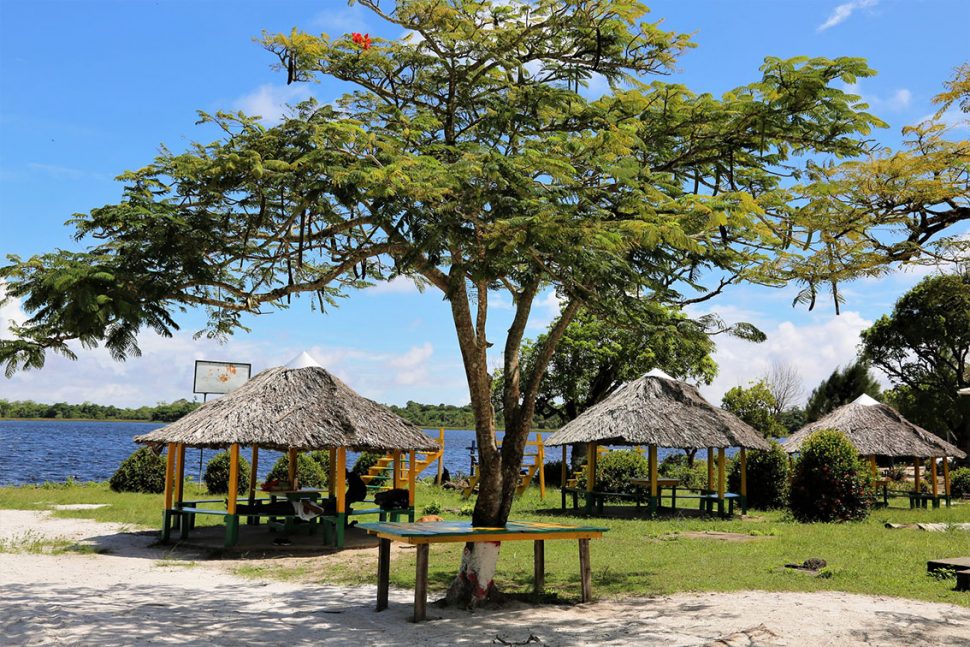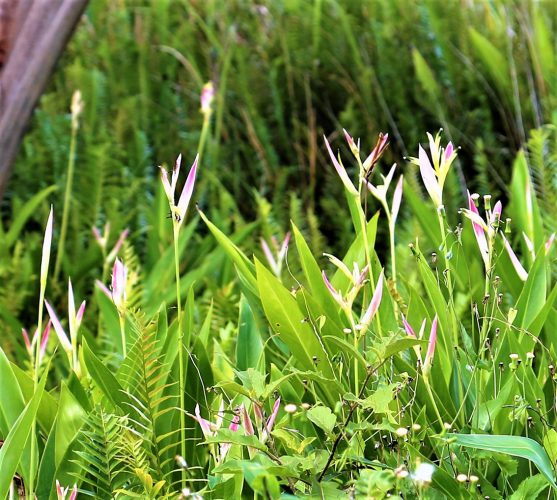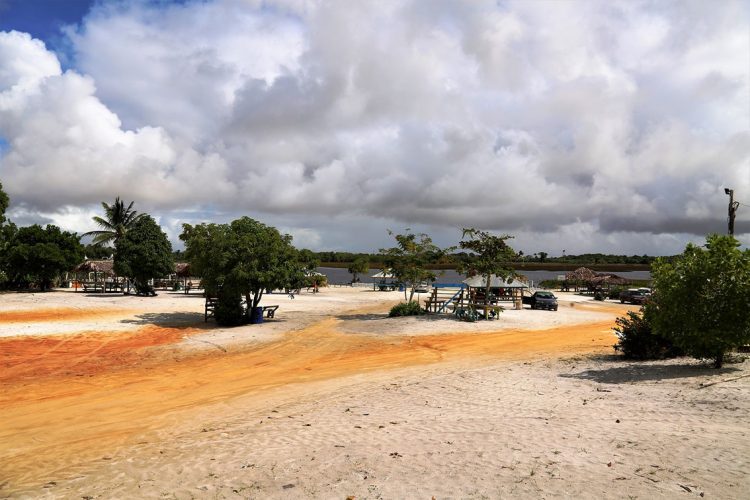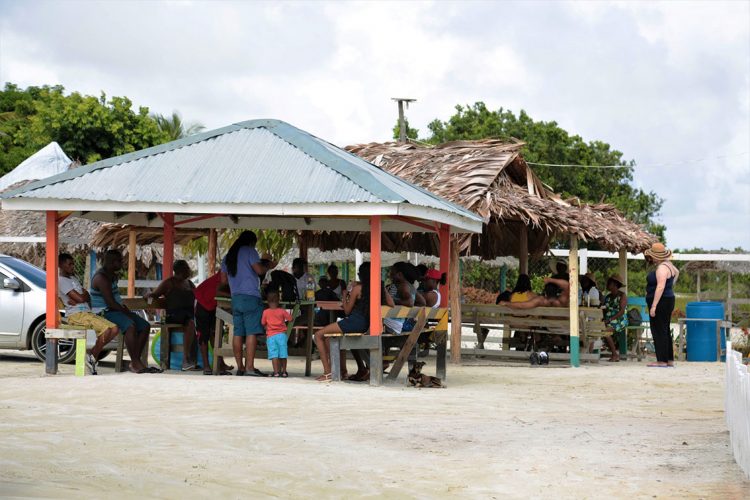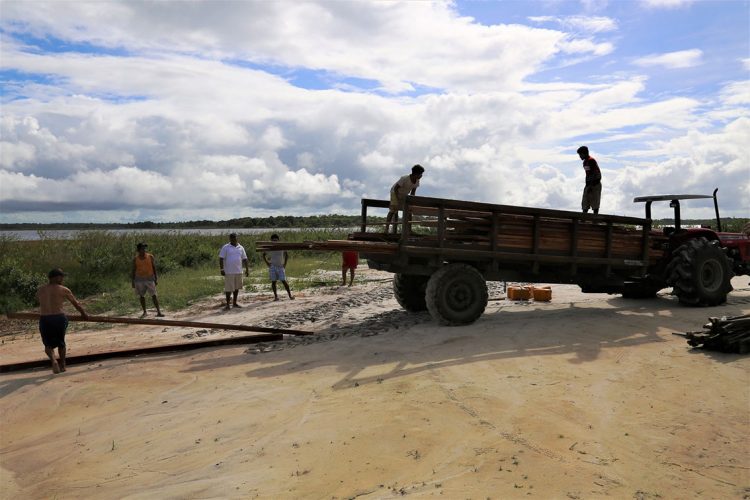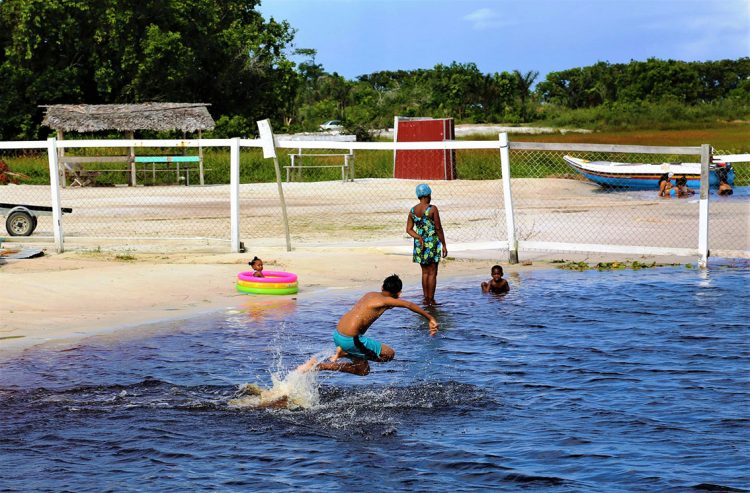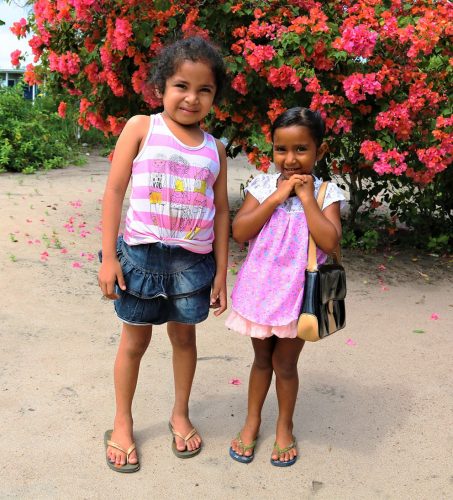Capoey is an Amerindian settlement in the Pomeroon/Supenaam region named for the lake on which it sits. To get there, one must travel along the Essequibo Coast. Between Taymouth Manor and Affiance villages, a red rutted road leads from the public road and disappears between rice fields and jamoon trees. The sign at the head of this road reads Lake Capoey.
Transportation along this road ranges between $1,000 and $2,000. The first stop, which was my destination, is at two wooden sheds that provide seating for passengers awaiting boats to take them across the lake to Capoey, the part of the village called ‘the Mission’. The cost of the trip across the lake to the Mission and back is $6,000. The second stop leads to the beach and the Capoey Lake Top. This scenic, black lake is one of three largest in Essequibo, the others are Mashabo and Mainstay.
Once on the boat, I could see two white dots in the distance and squinted at them assuming that was the village. I later learned that they were part of a settlement called Mary Point. However, the two families that live there are governed by the Capoey council. The ride to Capoey went a bit further as the village is situated on the other side obliquely opposite Mary Point.
A small percentage of the 515 residents are Caribs, with four persons being of mixed descent and the remainder belonging to the Arawak/Lokono tribe. Just a handful of them speak the Lokono language.
Capoey is said to be an Arawak word which means ‘the rise of the moon’. According to the story, centuries ago when the Europeans arrived they had enslaved the Amerindians. A group of Arawaks, made their escape at the rise of the moon by travelling across the lake into the jungle. Today, while there are persons residing at the Mission, in the scheme and along the lake, some still find comfort living in the surrounding jungle, including Toshao Ralph Hendricks.
He shared that the Mission was founded by the Methodist Church. The first school began under a starapple tree, with 15 children in attendance. Eventually, the school got its first structure, which was made of troolie palm. The second structure was of shingles and the third concrete which was later turned into a computer lab and another building was erected behind the lab. While the school is no longer run by the Methodists, the church prevails and is situated nearby. Other denominations have since made it into the village: Seventh Day Adventist, Full Gospel, Apostolic and Grace of God churches.
The main economic activities are farming and logging. A few persons work in the gold mines also. Hendricks, aside from the being the village captain, is a farmer. He plants ground provisions. A look around the village reveals giant fruit trees, some dating more than a century old along with flowering plants in bright colours. The village’s sandy, blackened soil seemed to be the reason for the thriving vegetation. The heliconia is one flower that abounds and a pale pink specimen was referred to by one visitor as ‘albino heliconia’.
Though the only mode of transportation to the village is by boat, persons walk to go everywhere else, whether to a neighbour, a shop, the nursery or primary schools or the health post. However, a few persons have motorcycles.
Capoey children who attend secondary schools elsewhere have a boat designated to take them across the lake. Previously they paid for this but no longer have to as the government takes care of gasoline expenses. There is a bus, also paid for by the government, which takes them as far as the Essequibo Coast Public Road. It is only from there that they pay transportation to get them to their respective schools.
The road leading to the lake, Hendricks said, was maintained by community members. The Capoey community, the proud captain said, is one that does not wait on the government for anything if they can get it done themselves. There are loam and sand pits owned by the village (situated at the back of Lake Top) and residents volunteer their labour. The pits also serve as income for Capoey.
Hendricks, whose term began last July, said he is making plans to rebuild part of the mission taking it ten feet out into the lake. Initially, the mission was bigger but erosion has taken a toll on the village’s landscape. He pointed out a hand pump almost covered by the lake, which was on dry land not so long ago. “I have made two proposals – one which I sent to the Minister of Amerindian Affairs – to help us with this project and the other proposal, well is to do it ourselves if we don’t get the help,” Hendricks said.
He first become toshao when he was 26 years old and still remains the only toshao to have been voted into the position at such a young age. He is a retired headmaster who was at Charity Primary School for almost nine years, before moving to Taymouth Manor Primary, from where he retired. Overall in his career, he taught for 31 years.
Though not many of the villagers maintain the eating habits of their people, Hendricks and his family still do. Their main dish is tuma pot (a clear sauce made from cassava water) eaten with rice or cassava bread which they keep topping up with meat and pepper whenever the meat runs out or has less flavour. They reheat it every day to keep it from spoiling. In most cases Hendricks’s tuma pot lasts for as long as a month. He gets his fish for this dish from the lake.
The villagers get their groceries from the coast while meat and fish are taken into the village to be sold. There are also small shops. Goods taken into the village are usually sold at high prices to cover the costs associated with getting them there. Even phone cards attract a mark up of $100. It was said that persons using the Digicel network don’t always have the best signal as it comes and goes depending on where the person is. The GTT signal strength is reasonably strong except for if persons venture way into the jungle, then they may just have to climb a tree to get signal.
Hendricks shared that while the village is mostly free of snakes, jaguars and ocelots prowl sometimes up to four times a year, making off with their dogs. Just last week, he said, dogs went missing. He recalled that they had caught a wild cat once and delivered it to EPA officials.
The villagers of Capoey love a celebration and heritage day is their biggest. The day begins as early as ten in the morning and goes until the following day. According to Hendricks, Capoey is popular with the visitors around this time and sometimes as much as 15 boats can be seen making their way to the mission.
Alfred Edwards sat in his hammock across opposite his wife under their house. He is 75 years old and had moved to the mission with his parents when he was eight. He does not recall where they came from. Edwards was one of the 15 children who were taught under the starapple tree.
“It had four benches and a blackboard. Our teacher was Ramdyal; he was a preacher. A school master had come in after; his name was Master Brandon,” he said in his fluent English. Edwards is one of the few who speak the Arawak language. He shared that it took him a long time to learn English.
In his younger years, he worked in the gold mines and did logging also. Of his eight children, seven are still alive. One of his sons, he said, had started learning the Lokono language but left it off eventually.
Edwards still farms today and sells cassava, watermelon and pumpkin from his home.
Later that day, he was among the pensioners collecting pension books from government officials at the Mission’s benab..
While many of the residents would have been born in the village or taken there by their parents at a tender age, Ryan Hoosein was drawn to Capoey another way. He shared his peculiar story, one the villagers were already familiar with and they laughed while they helped him tell it.
Hoosein sat where he could run over to his shop, a stone’s throw away, whenever a customer arrived. At first, he was eager to share, then not so sure when he realized it would be published, contemplating what his wife would say, but was persuaded by the villagers.
“I was working at Toroparo as an excavator operator… a mining district. A day I was trying to make a call by radio to a health centre at Mazaruni but the frequency got mixed up and I ended up calling the village council in Capoey. A girl [the secretary] answered and I fell in love with her voice from the first call. After that, I radioed her every day, Monday to Friday and we talked,” Hoosein said. Not only did he talk to her every day, but he sent her part of his salary every time he was paid for an entire year without having met her. He even asked for her hand in marriage over the radio and was given permission.
Finally, the day came when the two would meet. Hoosein had returned to his home in Soesdyke by then and the plan was that his mother would pick her up at the Soesdyke junction while he waited at home. Unable to contain his excitement, yet scared that he might be rejected, he followed his mother and sat at a bar across from the junction. What he saw, he said, was enough for him to be satisfied for she was a beauty, but he became even more worried that she might reject him. Concocting a plan, he switched places with the conductor of the bus she was taking and sat next to her, conducting the bus the rest of the way; he didn’t say a word to her about who he was. Once the bus arrived, he slipped off behind his mother and the girl and taking a short cut escaped to his room. When he heard her talking to his parents, he emerged with some money in his hand and she realized who he was and smiled.
“I told her that if she didn’t like what she see then she could take the money I had in my hand as passage to go back home,” Hoosein said. She did not return home until four months later and Hoosein followed her six months after that. The two have been together for 15 years and married for four. Their union produced three children, one of whom they lost to Leukemia.
Capoey, Hoosein said, was nothing different from what he had been used to in the interior where he worked. What he admires about the village is how clean it is kept. The people, he said, are friendly and he lives with them like family. Currently he works in the Barama River as an excavator operator. When he is at home he takes care of the shop and sometimes works his boat.
“I’d like to see more development pertaining to housing, roads in the village, electricity and a better water facility. Currently we depend on the solar panels for light and for water,” he noted.
Pamela Deyounge operates a shop at the Lake Top. She is part owner of Deyounge’s Access Beach, which is owned by seven sisters. “We didn’t have much land space living on the Mission,” she said. “After they started giving out house lots, we took the opportunity and applied.”
Her late father, Kenneth Deyounge, was toshao of Capoey for 26 years. The woman shared that the beach was actually a dream of her father’s who had wanted to live at the lake side. The lake, she said, was filled with ‘busy busy’ plants, but instead of clearing them out, they bought truckloads of sand and covered the wild growing plants turning the land into a beach. One particular family started visiting on the weekends, Jai Singh’s family from Affiance. They began telling people about the perfect getaway spot and very soon there were seven families who visited regularly. “Eventually we decided that having a beach opened to the public was something nice to do. My nephew Greg did the first two troolie roofs for the benabs; he was in secondary school at the time. By 2014, we had seven benabs; now we have 13. We charge a small entrance fee and the money we get at the gate, we keep investing it into the beach.
While I was there, preparations were being made to create a boardwalk on the lake with a benab attached that is expected to be bigger than the ones on the beach.
As we spoke more than 50 people were swimming and picnicking at the lake. More families kept arriving in pickups and buses with their food baskets and music. The beach is not officially open as yet, Deyounge said, but they are working assiduously on getting this done. She hopes to get electricity at Lake Top where she can have a refrigerator to keep whatever necessary to make fish and chips and to have cool beverages for sale. “We’re hoping to get a bus that will transport people from the ferry to the lake and back,” she said.
Living at Lake Top means that Deyounge and others have to travel to the Mission for water to cook since there is no well in the area. They use the lake water for washing and bathing and buy bottled water for drinking.
The mornings can be really cold, she said and they are often forced to close the windows from the wind, but the tranquility that comes with Capoey is nothing she could ever give up.
